Today, the significance of robust enterprise access management solutions has reached exceptional heights. IT managers persistently work towards fortifying digital assets and ensuring smooth access to vital resources. Thus, we present top enterprise access management solutions as vigilant gatekeepers for an organization's digital systems.
Enterprise access management solutions are a critical component of modern organizations' information security and identity management infrastructure. Their primary role is to bolster security and minimize risk by tightly regulating access to cloud-based resources, ensuring users only access what's appropriate for their roles.
These solutions encompass tools for managing access privileges and monitoring access activity, which is crucial for maintaining a secure and compliant operational environment. Whether securing user identities, managing access to applications, or ensuring compliance with regulations, these tools are pivotal in enhancing security, productivity, and efficiency for businesses across various industries.
What are Enterprise Access Management Solutions?
Enterprise access management solutions are integral systems designed to regulate and control access to an organization's digital assets and resources. Their pivotal role lies in ensuring that only authorized individuals or entities can interact with applications, data, systems, and networks within the organizational ecosystem.
Also known as EAMS, these solutions serve as centralized and secure platforms managing access to digital resources. They oversee critical aspects such as user identities, authentication, authorization, and permissions, maintaining stringent control to uphold the highest standards of security, compliance, and operational efficiency.
This structured and efficient approach to identity and access management safeguards sensitive data and mitigates security risks, ultimately enhancing the overall user experience.
Encompassing diverse practices, policies, and technologies, these solutions incorporate key components like authentication mechanisms, authorization protocols, and user provisioning processes. The overarching objectives of enterprise access management solutions remain constant: to bolster security measures, streamline user access, and ensure adherence to industry regulations.
Key Features Of Enterprise Access Management Solutions
Enterprise access management solutions, also known as EAMS, encompass a wide range of features and functionalities to help organizations manage and secure access to their digital resources effectively. The key features of these tools include:
- User Identity Management: EAM tools allow for creating, maintaining, and managing user identities within the organization. This includes user provisioning and deprovisioning.
- Authentication Methods: They support various authentication methods, such as passwords, multi-factor authentication (MFA), biometrics, smart cards, and more, to verify users' identities securely.
- Authorization: These tools define and enforce access policies, determining resources users can access based on their roles, responsibilities, and attributes.
- Role-Based Access Control (RBAC): Role-Based Access Control simplifies access management by assigning permissions to roles rather than individual users, streamlining access control and management.
- Single Sign-On (SSO): EAM tools often offer SSO capabilities, allowing users to log in once and access multiple applications without repeatedly entering credentials, improving user experience and security.
- Audit and Reporting: EAM tools generate detailed logs and reports to track user activities, access events, and security incidents, which are vital for compliance, incident response, and forensic investigations.
- Integration: EAM tools integrate with various other systems, including cloud services, on-premises applications, VPNs, and more, enabling centralized access control across diverse platforms and services.
- Password Management: They include password policy enforcement and self-service password reset functionalities, which enhance security and reduce help desk requests.
- Access Reviews and Certification: Regular access reviews and certification processes ensure access privileges remain current and appropriate, aiding in compliance efforts.
- Secure API Management: Some EAM solutions offer API gateways and management to control access to APIs, ensuring secure interactions between applications and services.
- Compliance and Governance: EAM tools assist organizations in achieving and maintaining compliance with various regulatory requirements and industry standards, such as GDPR, HIPAA, SOX, and more.
- Risk-Based Access Control: Advanced EAM solutions incorporate risk-based access controls that consider contextual information (like location, device, and behavior) to determine whether access requests are suspicious or potentially high-risk.
- Passwordless User Authentication: Some EAM solutions support passwordless authentication methods like biometrics or token-based authentication, which enhance security requirements and user convenience.
- Self-Service Access Requests: Thousands of users can request access to specific resources through self-service portals, streamlining the access provisioning process.
- Real-time Access Monitoring: EAM tools often provide real-time user access monitoring and can trigger alerts or take automated actions when suspicious activity is detected.
These key features collectively enable organizations to manage access to their digital assets, enhance security, ensure compliance, and streamline the user experience, making EAMS an essential component of modern identity and access management strategies.
Why Are Enterprise Access Management Solutions Essential?
Enterprise access management solutions and tools are essential for several compelling reasons, and their adoption significantly benefits organizations. Here are some key reasons why these systems are crucial in the modern business landscape:
- Heightened Security: Cybersecurity threats continuously evolve, and unauthorized access to digital resources is a significant risk. EAM systems enhance security by enforcing strict access controls, multi-factor authentication, and monitoring user activity. This helps protect sensitive data and prevent causes of data breaches and cyberattacks.
- Regulatory Compliance: Various industries are subject to stringent data protection regulations, such as GDPR, HIPAA, and SOX. EAM systems facilitate compliance by providing audit trails, access reviews, and user privilege management, ensuring organizations adhere to legal requirements and avoid costly penalties.
- Complex IT Environments: Many organizations today operate in hybrid environments with a mix of on-premises and cloud-based applications and services. EAM systems can seamlessly manage access across these diverse platforms, providing a unified approach to access control.
- Remote Work and Mobile Access: The proliferation of remote work and mobile devices has made access management more challenging. EAM solutions enable secure remote access and support mobile device management, ensuring employees can work from anywhere without compromising security.
- Productivity and User Experience: EAM systems often include Single Sign-On (SSO) capabilities, simplifying the login process for users. This enhances security and improves the user experience by reducing the need for multiple passwords and logins.
- Efficient Access Provisioning: These systems streamline user provisioning and deprovisioning, making it easier for IT teams to manage user access. This efficiency reduces the risk of lingering access to terminated employees and enhances operational productivity.
- Risk Mitigation: Risk-based access control, offered by some EAM systems, considers contextual information like user behavior and location to assess the risk of an access request. This proactive approach helps mitigate potential security threats.
- Password Management: EAM systems typically include password policy enforcement and self-service password reset capabilities, reducing the risk of password-related security incidents and minimizing help desk support requests.
- Audit and Reporting: Detailed logs and reports generated by EAM systems provide visibility into user activities and access events. This data is invaluable for auditing, security incident investigations, and ensuring accountability.
- Scalability: Many EAM solutions are cloud-based, offering scalability and flexibility to accommodate an organization's growing needs. Cloud-based solutions also reduce the burden of maintaining on-premises hardware and software.
- Cost-Efficiency: By automating access management processes, EAM systems can reduce administrative overhead, lower operational costs, and provide a rapid return on investment.
To sum up, enterprise access management solutions are essential because they address the evolving challenges of modern business operations. They enhance security, facilitate compliance, support remote work, improve user experiences, and streamline access management processes.
By adopting these systems, organizations can protect their digital assets and operate more efficiently and effectively in an increasingly complex and interconnected digital world.
Top 11 Enterprise Access Management Solutions
When selecting enterprise access management solutions, organizations should carefully evaluate their specific requirements and choose the one that aligns best with their goals and operational needs. Below are some EAM systems that offer a range of features and capabilities, catering to the diverse needs of modern organizations.
1: Zluri
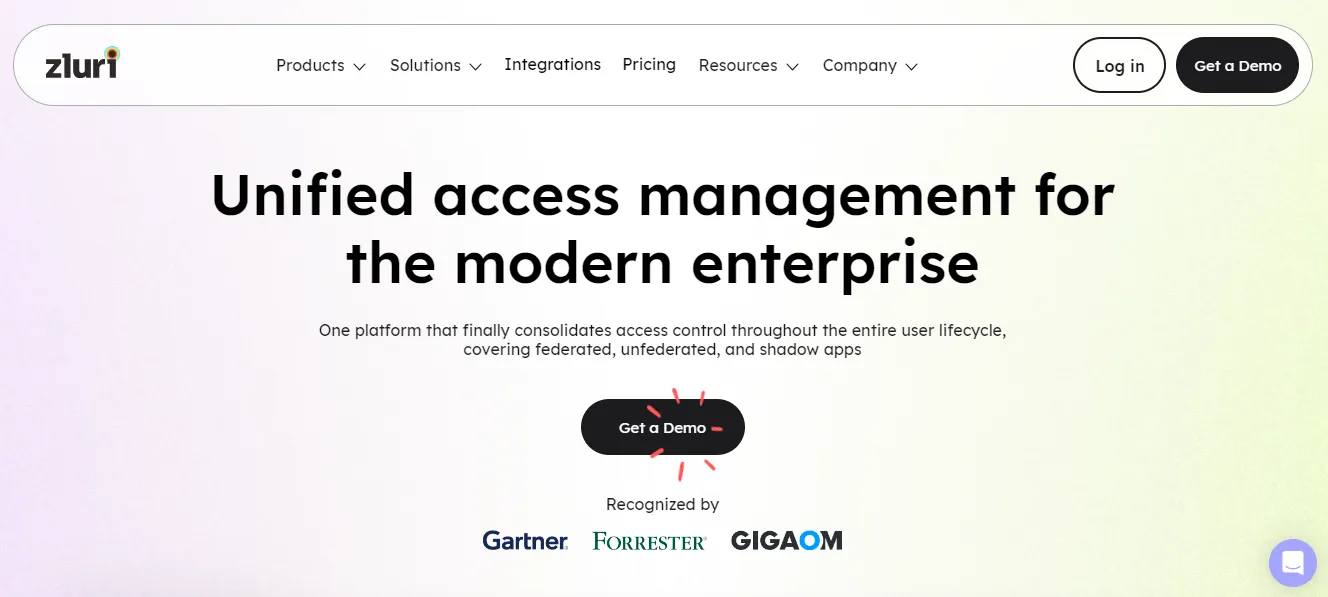
Zluri offers an integrated enterprise access management system, providing efficient control over access rights through a user-friendly central dashboard. This unified approach ensures your IT team's authority in managing user access to essential systems and data, aligning with organizational policies for security and compliance.
Additionally, Zluri streamlines tasks by integrating with your HR system, ensuring accurate employee information for identity verification during onboarding and offboarding procedures. With features like automated user provisioning, access reviews, and self-service access requests, Zluri simplifies access management for enhanced control and security.
Here's how Zluri assists with enterprise access management:
Key Features
- Centralized Access Management:
Zluri provides a centralized platform to efficiently manage user identities, access controls, and permissions across enterprise systems. This streamlines processes for IT administrators, offering a unified interface for user provisioning, deprovisioning, group management, and security policy enforcement.
- Role-Based Access Control (RBAC):
Support for Role-Based Access Control (RBAC) enables organizations to define roles and associated permissions based on job functions. IT administrators can easily assign and manage access rights at scale, balancing user tasks and security considerations.
- Comprehensive Reporting:
Zluri's robust reporting capabilities monitor user activities, track access changes, and generate detailed reports for regulatory compliance. This ensures adherence to internal policies and provides valuable insights into access management.
- Integration with Enterprise Systems:
Its seamless integration with directories, HR systems, and other cloud platforms ensures synchronized user identities and access controls. With direct integration to over 300 SaaS applications, Zluri offers continuous data flow, insights, and AI-powered alerts, simplifying platform management and ensuring a consistent user experience.
- Single Sign-On (SSO) Support:
Zluri integrates with Single Sign-On (SSO) tools, allowing users to access multiple applications with a single set of credentials. This enhances user experience, boosts productivity, and minimizes password-related security risks, such as phishing attacks.
- Access Request and Approval Workflows:
Facilitating self-service access request workflows, Zluri enables employees to request permissions for their favorite apps. IT admins can instantly review and approve requests based on predefined policies, reducing administrative overhead and employee waiting times.
- Regular Access Reviews:
Zluri's access review solution enhances security and compliance by consistently monitoring user access to sensitive data. Identifying and mitigating potential security risks ensures that only authorized users access critical systems, reducing the risk of data breaches and unauthorized access.
Overall, Zluri's unified access management empowers It teams to manage user access effectively, strengthen security controls, improve compliance posture, and enhance user experience across the enterprise. By offering a extensive set of features and capabilities, Zluri enables organizations to achieve robust access management tailored to their specific business needs and security requirements.
Schedule a demo to learn more!
Customer Rating
- G2: 4.8/5
- Capterra: 4.9/5
2: ACQUIa
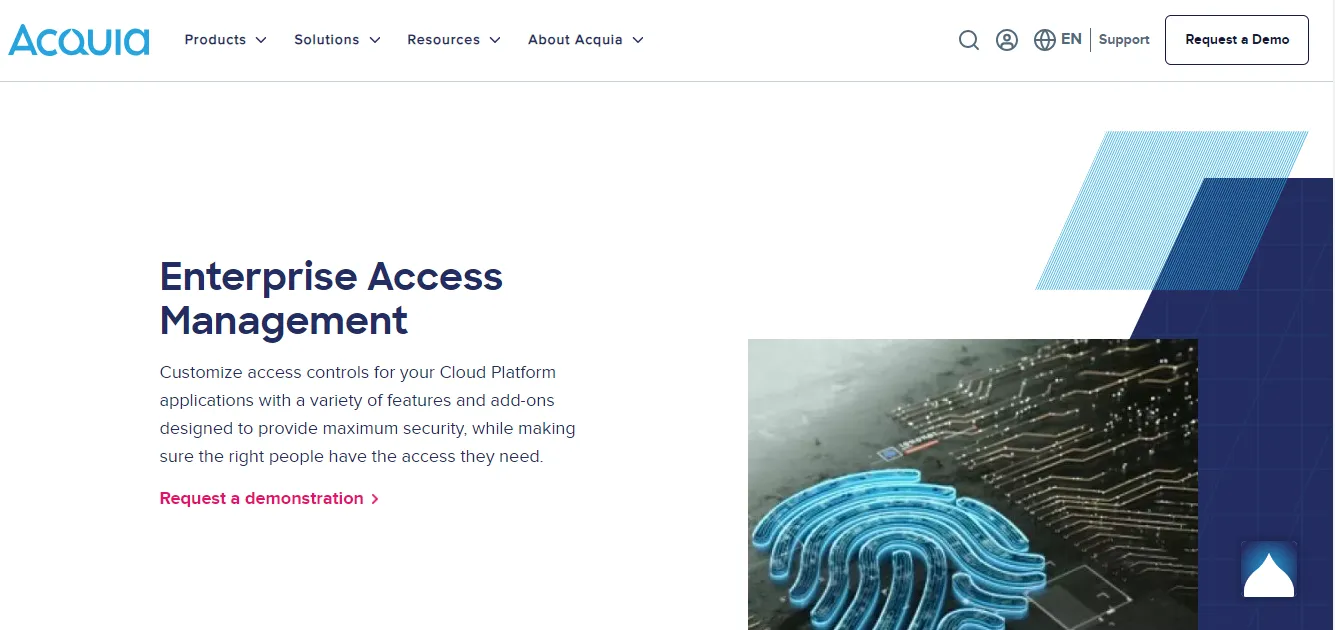
Acquia offers an extensive solution for overseeing access to digital resources and systems within your enterprise. This comprehensive platform empowers your team with a centralized hub for identity discovery, access management, and real-time monitoring across the entire organization.
Acquia simplifies the intricate processes of user provisioning, access request handling, and permissions modifications by providing a unified view of user access rights, permissions, and entitlements. This enhances efficiency and enables a proactive approach to access governance.
Furthermore, Acquia's robust access management capabilities streamline operations, enhance security, and maintain compliance. This ensures the protection of your digital assets while meeting regulatory standards. Thus, its access management capabilities go beyond operational efficiency, prioritizing security and compliance to safeguard your digital assets and ensure adherence to regulatory standards.
Key Features
- Seamless Setup and Integration: Acquia access management integrates with your existing infrastructure, ensuring a smooth setup process that minimizes disruptions to daily operations.
- Passwordless Authentication: It reduces password reliance by including passwordless authentication options. This not only bolsters security but also simplifies the login experience for your employees.
- Extensive App Catalog: Acquia boasts an extensive catalog of pre-configured applications, simplifying the process of adding and managing access to popular business tools.
- Real-time Monitoring and Alerts: Monitor potential security threats through Acquia SSO's real-time monitoring and alert system. It promptly notifies you of any suspicious activities, facilitating rapid responses.
Customer Rating
- G2: 4.3/5
- Capterra: 4.3/5
3: SolarWinds
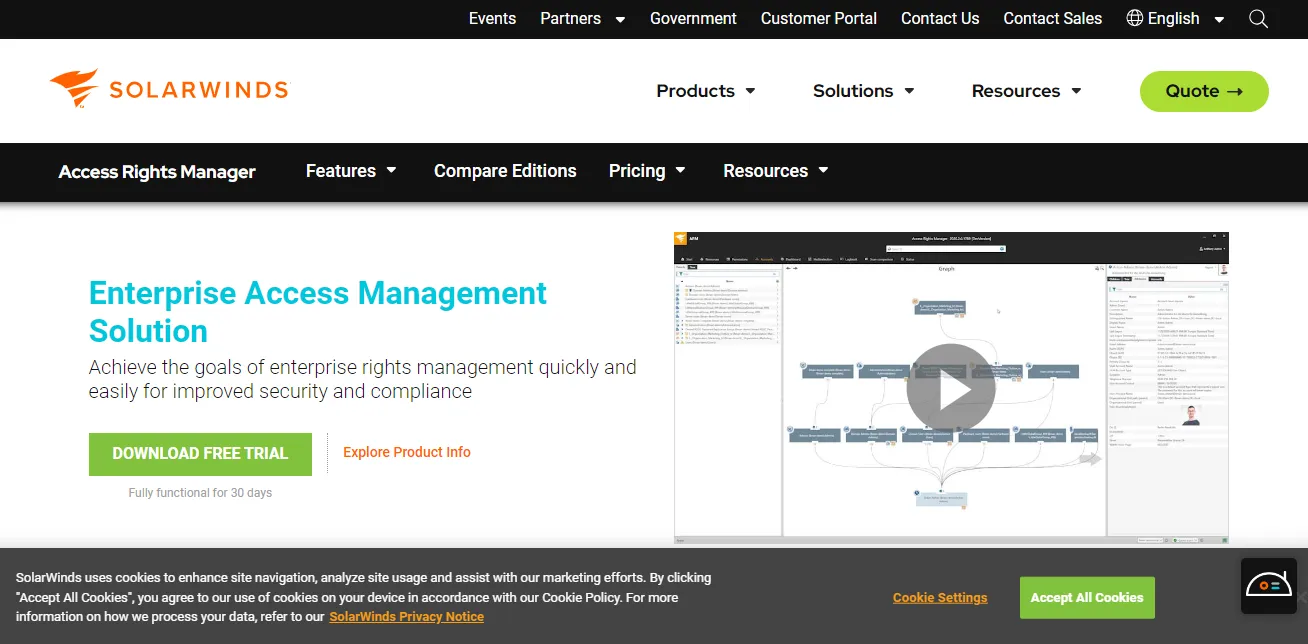
SolarWinds Access Rights Manager (ARM) is a comprehensive enterprise access management technology solution. It empowers your team to manage user access efficiently, enforce stringent security policies, and seamlessly maintain compliance standards.
SolarWinds ARM offers a formidable suite of user access management capabilities at its core. It provides you with the tools needed to comprehensively oversee and exert control over user privileges across a diverse range of systems and applications.
With ARM, granting or revoking access rights becomes straightforward, and you can efficiently manage user roles while optimizing the onboarding and offboarding processes. This enhances your organization's security posture and streamlines intricate access control, facilitating a robust and compliant environment for your enterprise.
Additionally, ARM offers advanced reporting and auditing capabilities, providing transparency into user access activities and aiding in compliance assessments.
Key Features
- Comprehensive User Access Management: SolarWinds Access Rights Manager provides extensive capabilities to manage user access efficiently, including granting and revoking access rights.
- User Role Management: You can efficiently manage user roles, optimizing onboarding and offboarding processes while enhancing security.
- Compliance Standards Maintenance: Access Rights Manager facilitates the seamless maintenance of compliance standards, making regulatory compliance less complex and stressful.
- Transparent User Access Activities: It offers transparency and visibility into user access activities, ensuring accountability and security.
- Robust Access Control Environment: The platform creates a robust and compliant access control environment for your enterprise, enhancing security and efficiency.
- Advanced Reporting and Auditing: The tool offers advanced reporting and auditing features, providing transparency into user access activities and aiding in compliance assessments.
Customer Rating
- G2: 4.3/5
- Capterra: 4.6/5
4: Okta Workforce Identity
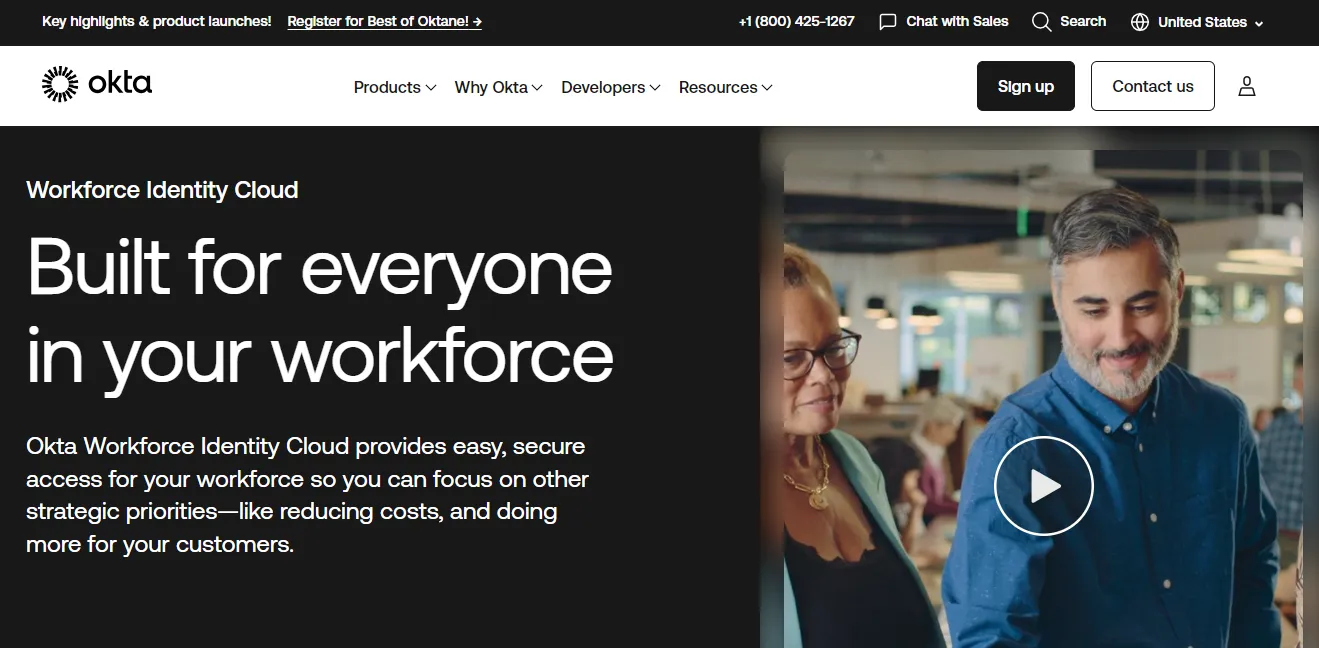
One of the prominent Enterprise Access Management Solutions is "Okta Workforce Identity." Okta is a leading provider of identity and access management solutions that help organizations secure and control access to their digital resources.
It centralizes all applications, providing seamless access through single sign-on, eliminating the need to manage multiple passwords for each application. Okta empowers users to access any application from any device, anytime and anywhere.
Okta boasts an intuitive and user-centric interface, streamlining the management of user identities and access control. With the ability to effortlessly configure policies, access reports, and monitor security through a centralized dashboard, Okta enhances your operational efficiency and effectiveness.
Key Features
- Access Certification and Review: Okta effortlessly assesses user entitlements with customizable workflows, streamlines certification campaigns, and ensures compliance with regulatory frameworks.
- Role-Based Access Control (RBAC): It helps you define roles, assign access privileges, and manage access efficiently, reducing unauthorized access risks and granting appropriate permissions based on job roles.
- Policy Enforcement and Violation Management: The platform helps you define access policies and automatically enforce them while monitoring access, detecting violations, and triggering alerts or remediation actions.
- Audit and Reporting: Furthermore, it simplifies audits with extensive trails and reporting, tracking user access changes, access request history, and approval workflows.
Customer Rating
- G2: 4.5/5
- Capterra: 4.6/5
5: Ping Identity

Ping Identity provides a powerful Enterprise Access Management tool designed to bolster security. It simplifies access control across networks, APIs, cloud-based applications, and on-premises software. Employing advanced AI technology, this platform takes a proactive approach to detecting and addressing suspicious activities, all while ensuring compliance with industry regulations.
This versatile EAM tool empowers organizations to establish comprehensive access policies to protect sensitive resources. It facilitates seamless integration, synchronization, and data archiving from various sources, consolidating this data into a centralized repository for efficient and effective management. Moreover, Ping Identity offers a user-friendly interface that simplifies the configuration and management of access policies, reducing administrative overhead.
Key Features
- Seamless Integration: Ping Identity's SSO seamlessly integrates with various applications, including both cloud-based and on-premises systems. This flexibility lets you maintain your preferred tools while enhancing security and convenience.
- Effortless Compliance: The solution aids in enforcing access policies and generates comprehensive audit logs for simplified compliance reporting, reducing the stress of audits.
- User Self-Service: Empower your users with Ping Identity's self-service features, enabling them to reset passwords, manage their profiles, and access the self-service functionality. This not only lightens the load on your IT team but also encourages a sense of ownership and responsibility among your employees.
- Centralized Access Control: It simplifies the onboarding and offboarding processes by granting and revoking access promptly from a single, organized hub. No more navigating complex user permission structures – everything is conveniently centralized.
- Scalability: Whether your organization is small, medium, or large, Ping Identity's SSO tool effortlessly scales to accommodate your needs. As your company expands, there's no need for a complete overhaul of your authentication processes – simply expand your Ping Identity solution to accommodate new users and applications.
Customer Rating
- G2: 4.4/5
- Capterra: 4.8/5
6: StrongDM
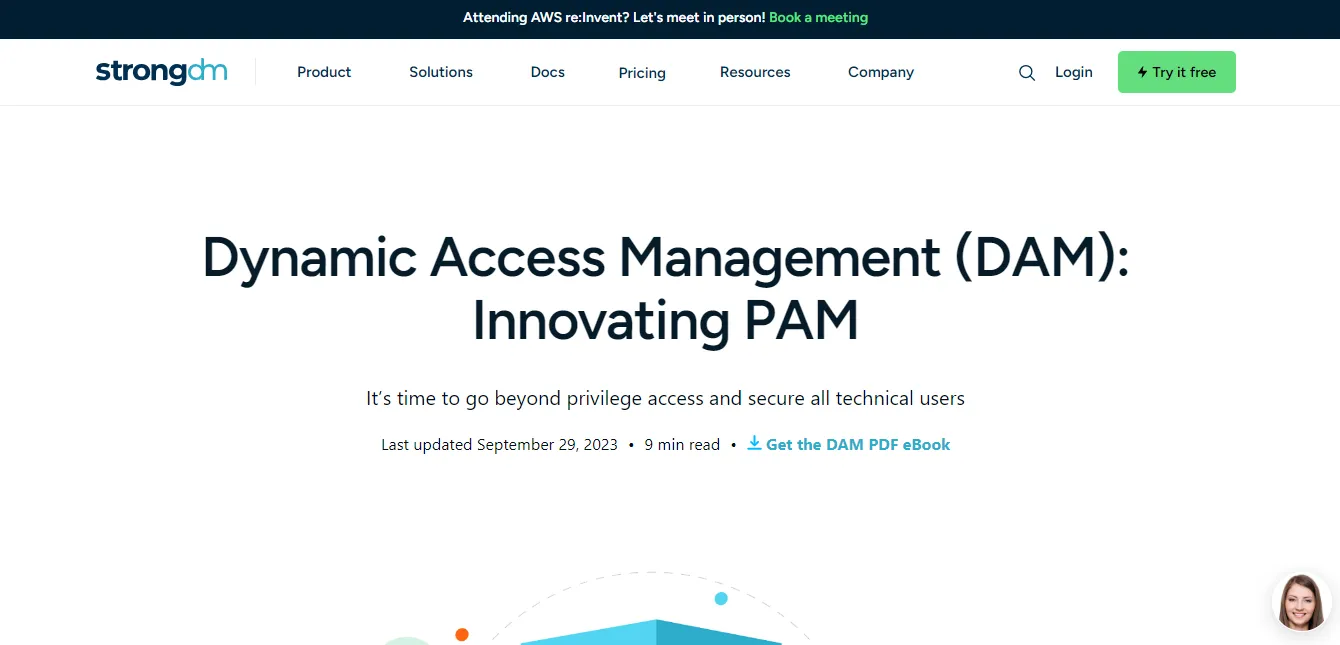
StrongDM provides a comprehensive access management solution that simplifies access governance procedures, thus ensuring the utmost security and control over your organization's invaluable resources.
One of its key attributes is its centralized access control system, which equips your team with the tools necessary to establish consistent access policies across all your resources.
This centralized control mechanism empowers you to precisely define fine-grained access permissions and subsequently enforce them uniformly across various components such as databases, servers, and cloud infrastructure. This bolsters security and streamlines access rights management, providing an efficient and robust foundation for your organization's access governance framework.
With StrongDM, you can maintain a seamless and secure access control environment that aligns with your organization's evolving needs while upholding the highest data security standards.
Key Features
- Centralized Access Control: StrongDM provides a centralized control system to establish and manage access policies uniformly across all resources, such as databases, servers, and cloud infrastructure.
- Fine-Grained Access Permissions: It enables organizations to define granular access permissions precisely, ensuring users only have access to the specific resources they need.
- Data Encryption: StrongDM employs advanced encryption techniques to protect data both at rest and in transit, ensuring the security and confidentiality of sensitive information.
- Password Management: It provides secure password vaulting capabilities, reducing the risk of password-related security incidents.
- Audit and Compliance Reporting: StrongDM includes comprehensive audit and compliance reporting tools to help organizations meet regulatory requirements and maintain a secure access environment.
Customer Rating
- G2: 4.7/5
- Capterra: 0/0
7: Auth0
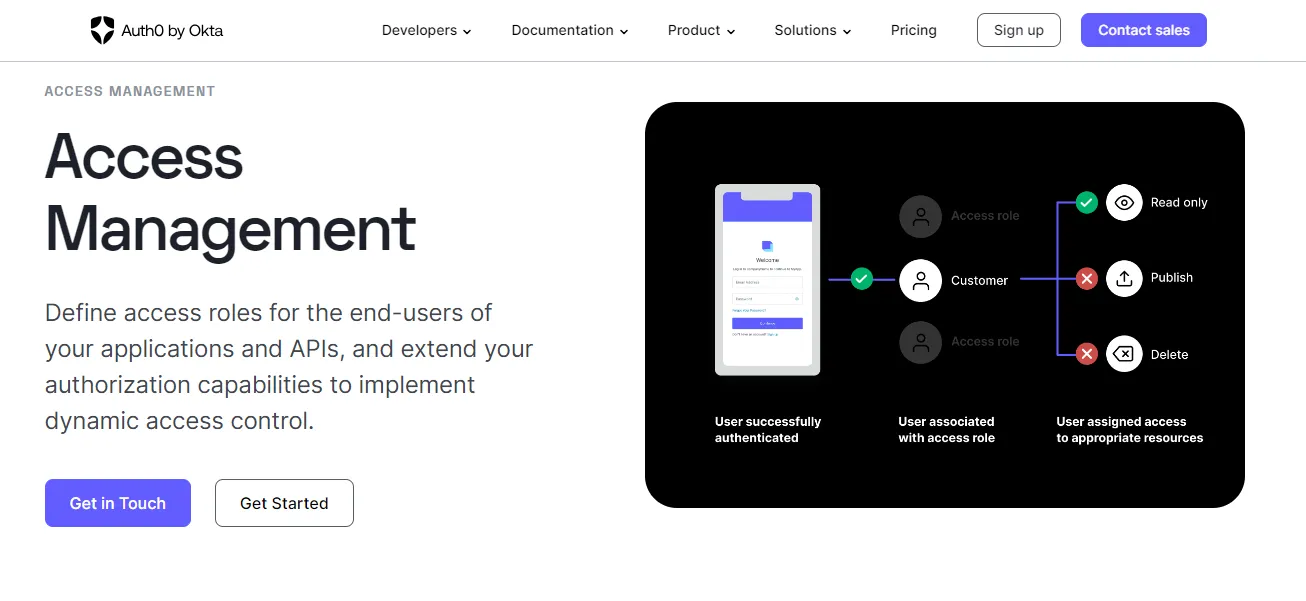
Auth0 is a robust enterprise access management tool providing compelling access control methods. It is dedicated to securing access to applications while prioritizing user data privacy and security, fostering trust within organizations, and enabling heightened productivity.
This EAM tool simplifies the authentication process through various features, including unified login, single sign-on, multi-factor authentication, two-factor authentication, and more. By doing so, it streamlines access management, fortifies user application interactions, and solidifies Auth0's position as a compelling identity and access management solution.
Furthermore, it facilitates low-code integrations, aligning seamlessly with the contemporary workforce. Moreover, it vigilantly oversees application data and monitors activities through third-party integrations integrated within the platform.
Key Features
- Session Recording and Monitoring: Auth0 provides robust session recording and monitoring features. This capability enables real-time monitoring of privileged accounts and user activities, allowing for prompt identification and response to suspicious behavior.
- Least Privilege Access: By adhering to the principle of least privilege, Auth0 ensures that users are granted access only to resources essential for their respective roles. Auth0's IAM solution allows for the precise definition of access controls, effectively shrinking the attack surface and bolstering identity security.
- Privilege Elevation: With Auth0's privilege elevation capabilities, users can temporarily escalate their privileges for specific tasks without exposing sensitive credentials. This 'just-in-time' access minimizes exposure and mitigates the risks associated with prolonged elevated privileges.
- Privileged Access Management (PAM): Auth0's identity and access management platform is anchored by its cutting-edge privileged access management functionalities. It empowers you to control, monitor, and secure access to privileged accounts, thereby reducing the risk of unauthorized access and data breaches.
- Password Vaulting: Auth0 offers a secure password vault for storing sensitive credentials in an encrypted format. This practice eliminates the common habit of storing passwords in spreadsheets or on sticky notes, effectively lowering the risk of password-related security incidents.
Customer Rating
- G2: 4.3/5
- Capterra: 4.6/5
8: IBM Security Verify
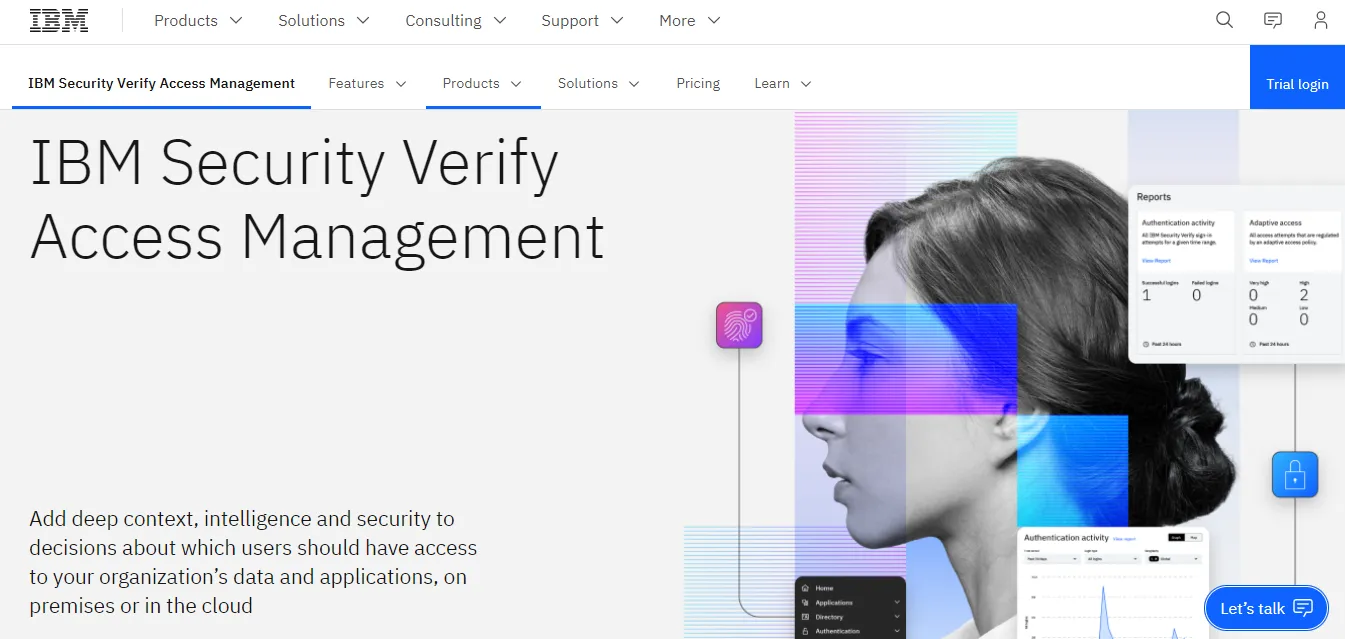
IBM Security Verify Access represents a groundbreaking advancement in enterprise access management solutions, providing your team with a comprehensive suite of features and capabilities to simplify user access management and bolster security protocols. It seamlessly integrates robust multi-factor authentication (MFA) options, encompassing biometrics, one-time passwords, and smart cards, guaranteeing that only authorized users can access vital systems and data.
Built with scalability and high availability, IBM Security Verify Access ensures uninterrupted access to critical applications, even during peak usage. It offers a user-friendly interface that minimizes friction for your employees. Users can access multiple applications and services effortlessly using a single set of credentials. This not only enhances productivity but also elevates user satisfaction.
Key Features
- Adaptive Access Policies: Intelligent adaptive authentication policies adapt to user behavior, detecting anomalies and triggering advanced authentication when needed. This extra layer of security maintains user convenience while bolstering protection.
- Single Sign-On for Mobile Devices: IBM Security Access enables secure access to corporate resources from smartphones and tablets, enhancing user flexibility without compromising security, even on mobile platforms.
- Passwordless Authentication: Support for passwordless authentication methods, like fingerprint and facial recognition, eliminates the need for cumbersome passwords, streamlines user access, and enhances security.
- Self-Service Password Reset Tool: Reduce the burden on IT support with self-service password reset features. Users can securely reset their passwords, minimizing downtime and frustration while promoting efficiency.
- Multi-Factor Authentication (MFA): IBM Security Access offers robust MFA options, including biometrics, one-time passwords, and smart cards, enhancing security by ensuring only authorized users access critical systems and data.
Customer Rating
- G2: 4.3/5
- Capterra: 4.3/5
9: AWS Identity & Access Management (IAM)
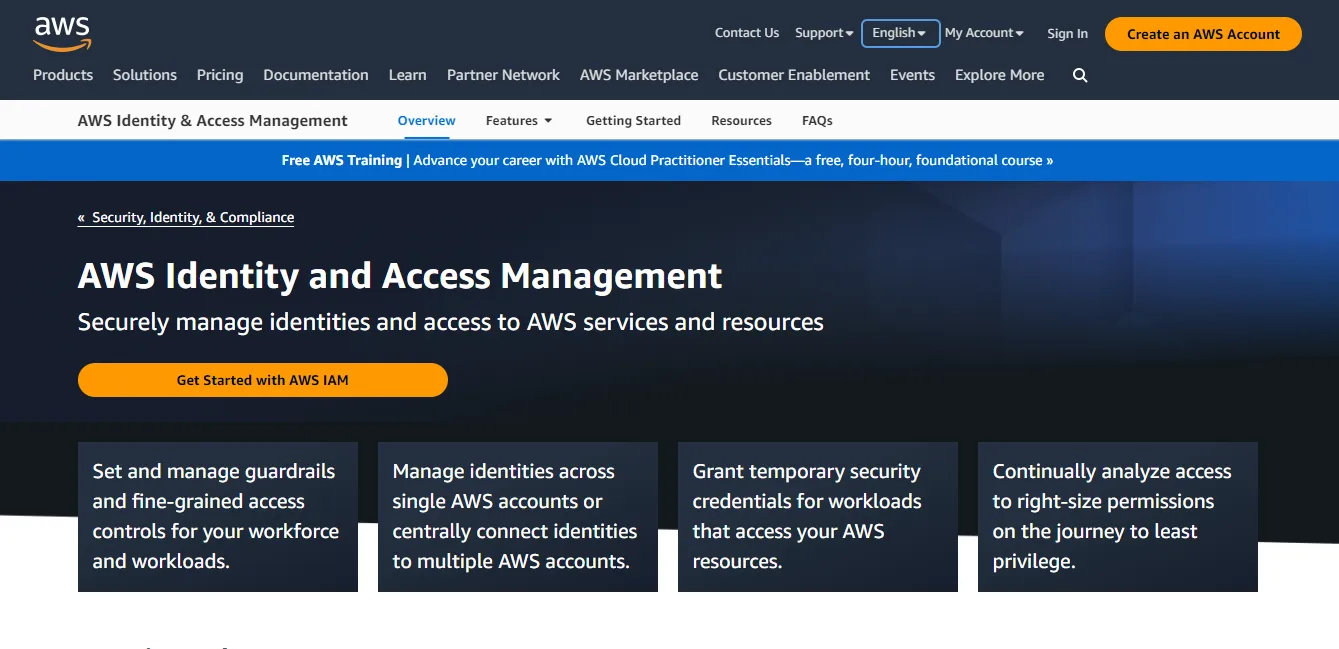
AWS Access Management is a cloud-native solution designed to streamline the administration of access to AWS resources, third-party applications, and custom applications. It offers the convenience of centralized access control. This simplifies the management of user identities and access rights across various accounts and applications, enhancing security while minimizing administrative burdens.
AWS SSO ensures a seamless, one-click sign-on experience for users. After successful authentication, users can effortlessly access all assigned applications without the hassle of multiple passwords. This not only boosts user productivity but also mitigates the risk of security breaches related to passwords.
Key Features
- Unified Access Control: AWS SSO serves as a central hub for managing access to AWS accounts and applications. It facilitates swift assignment and revocation of access rights for users and groups, ensuring precise access control for the right individuals at the right time.
- Built-in Multi-Factor Authentication (MFA): Prioritizing security, AWS SSO incorporates MFA as an integral feature. It enables your team to mandate users to authenticate through a second factor, such as a mobile app or hardware token, fortifying protection with an additional layer.
- Single Sign-On Portal: AWS SSO provides a customizable user portal for streamlined application access. This portal can be tailored to reflect your organization's brand, delivering a consistent and professional user experience.
- Secure Token Service (STS) Integration: AWS SSO seamlessly integrates with AWS Security Token Service (STS), granting users just-in-time permissions to assume roles in AWS accounts. This minimizes credential exposure and elevates overall security.
- Cost-Efficiency: Simplifying access management and reducing security risks, AWS access management offers the potential for cost savings. It decreases the administrative resources required for access control while diminishing the likelihood of costly security incidents.
Customer Rating
- G2: 4.5/5
- Capterra: 4.7/5
10: SailPoint

SailPoint's enterprise access management solutions provide a comprehensive platform to help organizations manage user access and permissions across their applications and data effectively. It allows organizations to centralize and streamline user access control. This means administrators can manage access to all their applications and data from a single, unified dashboard. This simplifies access management and reduces the risk of errors and security gaps.
It generates audit-ready reports, which are crucial for demonstrating compliance to auditors, stakeholders, and regulators. These reports provide insights into who has access to what data, how they acquired it, and their level of access. This transparency is essential for security and compliance purposes. Further, it includes user behavior monitoring capabilities. It tracks user activities and identifies any irregular or suspicious actions.
Key Features
- Identity Governance: SailPoint offers robust identity governance capabilities, allowing you to seamlessly manage user identities across your hybrid environment. This ensures that the right individuals always have access to the appropriate resources, simplifying user lifecycle management.
- Access Management: SailPoint equips your team with advanced access management tools for fine-grained control over user privileges. You can define and enforce access policies to mitigate the risk of unauthorized app access and reduce the potential attack surface.
- Single Sign-On (SSO): It enhances user experience and productivity through SailPoint's SSO feature, streamlining access to multiple applications. This not only bolsters security but also alleviates the burden on IT support.
- Password Management: The tool simplifies password management with self-service password reset options, reducing support ticket volumes and increasing user satisfaction. SailPoint empowers users to manage their passwords more efficiently.
- Risk-Based Authentication: It enables you to implement risk-based authentication to assess the risk level associated with each access attempt. This feature enables you to tailor security measures to the specific risk profile, enhancing overall security.
Customer Rating
- G2: 4.4/5
- Capterra: 4.2/5
11: ForgeRock
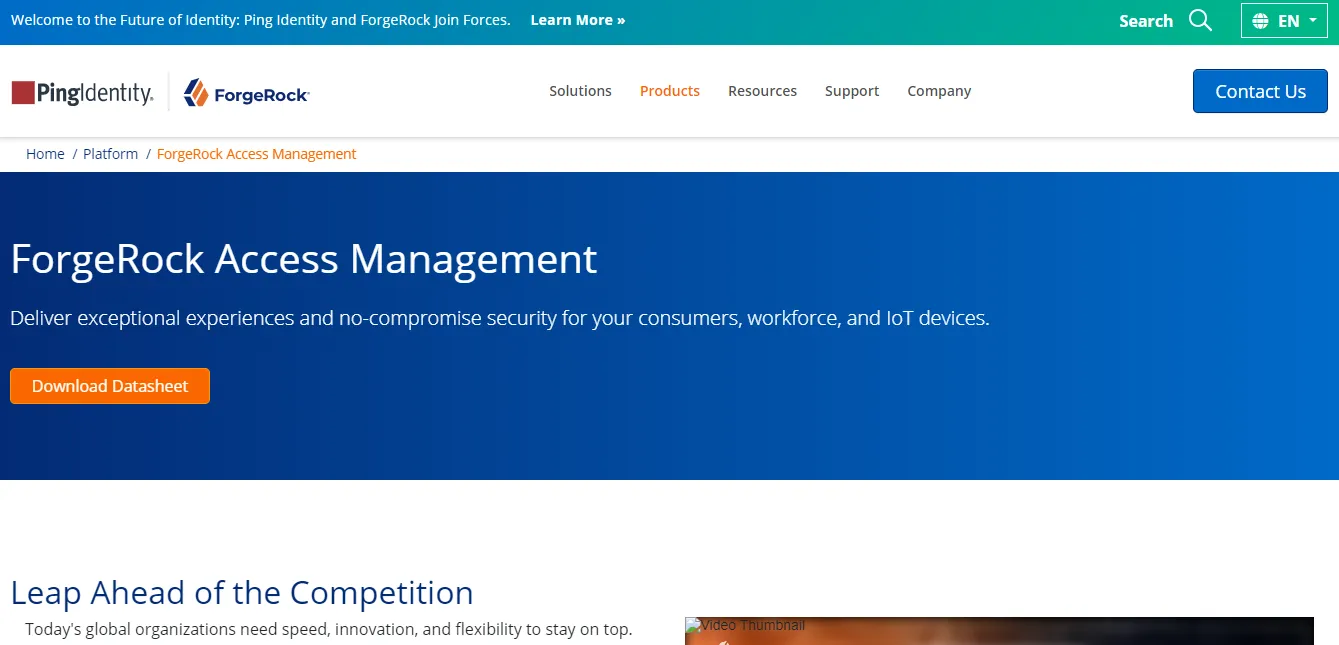
The ForgeRock Identity Platform offers robust enterprise access management solutions featuring cutting-edge cloud infrastructure and artificial intelligence capabilities. It simplifies the process of overseeing, safeguarding, and administering all user identities within your organization.
This tool guarantees that only authorized individuals have entry to your organizational assets, acting as a protective barrier against potential security risks and data breaches. Furthermore, it optimizes operational efficiency by automating account creation and removal and streamlining various other tasks, reducing reliance on manual intervention and minimizing human errors.
Key Features
- Single Sign-On (SSO): ForgeRock simplifies user access by offering an SSO capability. This means that users only need to log in once to gain access to various applications, boosting security and reducing password-related hassles.
- Multi-Factor Authentication (MFA): ForgeRock incorporates MFA, adding an extra layer of security by requiring users to provide multiple forms of authentication. The tool enhances security by requiring multiple forms of authentication, like fingerprints, tokens, or SMS codes, making unauthorized access highly unlikely.
- User Self-Service Portal: It empowers users with a user-friendly portal for password resets, profile management, and resource access requests, reducing IT workload and improving efficiency. Allowing users to manage their own access and profile information reduces the workload on your IT team and improves overall efficiency.
- Adaptive Authentication: ForgeRock's adaptive authentication engine uses advanced analytics to assess risk and dynamically adjust security measures accordingly. For example, if it detects login attempts from unusual locations or devices, it can respond with additional security checks, such as requiring MFA.
- Identity Lifecycle Management: ForgeRock offers a robust capability for provisioning and deprovisioning user accounts. It effectively manages creating and removing user accounts, ensuring that individuals have appropriate access when needed, thereby boosting compliance and mitigating security risks.
Customer Rating
- G2: 4.4/5
- Capterra: 5/5
Choose The Best Enterprise Access Management Tool
In the pursuit of the optimal Enterprise Access Management Tool, the overview of 11 top solutions provides a valuable starting point. However, selecting the right user access management platform necessitates a comprehensive evaluation of critical factors such as cost, complexity, scalability, integration capabilities, automation features, and reporting capabilities. Your decision-making process should be guided by a strategic approach involving the creation of a tailored list of feature requirements specific to your organization's needs.
This systematic list becomes a guiding framework, aiding in the identification of vendors that align best with your unique requirements and priorities. By meticulously analyzing these aspects, you ensure that the chosen platform seamlessly fits your business requirements.
Ultimately, the decision lies with you on which platforms to explore further. Conducting a thorough evaluation based on your defined criteria will lead you to the most suitable choice for your organization's evolving needs.
FAQs
1: What is enterprise access management?
Enterprise access management refers to the comprehensive set of practices, policies, and technologies designed to regulate and control access to an organization's digital systems and resources. It ensures that only authorized users and entities can access applications, data, systems, and networks.
2: What are access management solutions?
Access management solutions are specialized tools or systems implemented by organizations to effectively control and monitor access to their digital assets. These solutions typically include features such as authentication, authorization, and user provisioning to manage and secure access to applications, data, and networks.
3: What is the best IAM solution?
Determining the best Identity and Access Management (IAM) solution depends on various factors such as organizational needs, size, and specific requirements. Several reputable IAM solutions are available, including but not limited to Okta, Microsoft Azure Active Directory, and Ping Identity. Choosing the most suitable solution involves evaluating features, scalability, and compatibility with organizational goals.
4: What is the difference between IAM and IdM?
IAM (Identity and Access Management) and IdM (Identity Management) are often used interchangeably, but there is a subtle distinction. IAM encompasses the broader scope of managing both identities and access rights, covering authentication, authorization, and administration. IdM, on the other hand, primarily focuses on the management of user identities, including attributes and credentials. In essence, IdM is a subset of IAM, which addresses a more comprehensive range of identity and access-related functionalities.
5: What are the benefits of enterprise access management solutions?
Enterprise Access Management Solutions (EAMS) provide enhanced security, centralized access control, streamlined user access, compliance adherence, improved operational efficiency, user-friendly experiences, risk mitigation, and cost savings. These solutions offer a comprehensive approach to managing access to digital resources, ensuring organizations can optimize security, efficiency, and user experience while adhering to compliance standards and minimizing costs.






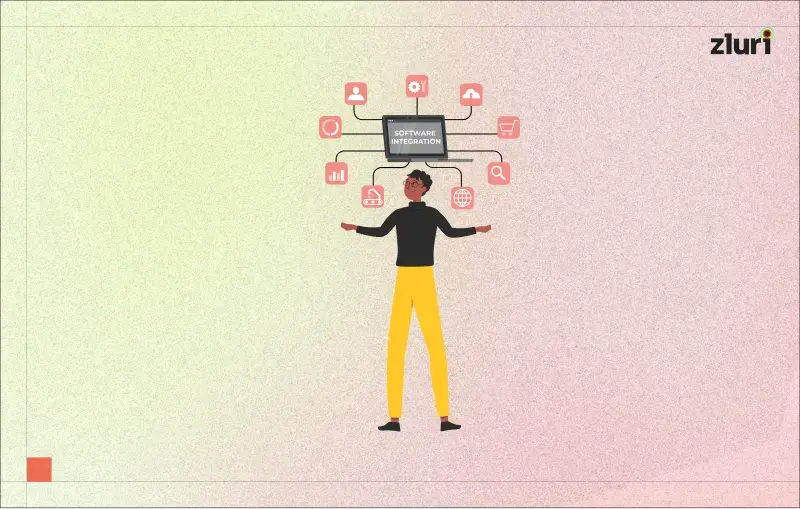

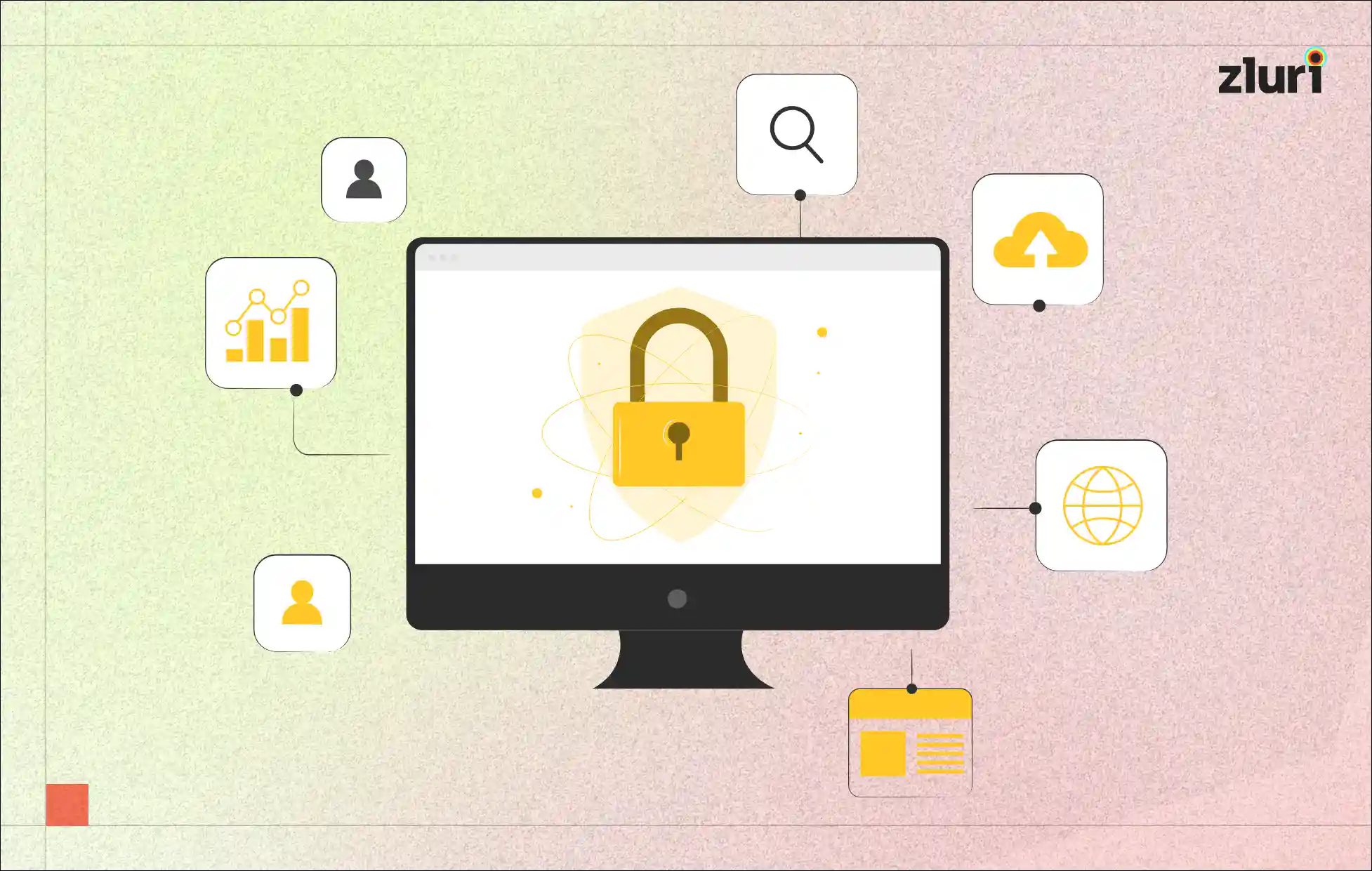
.svg)














